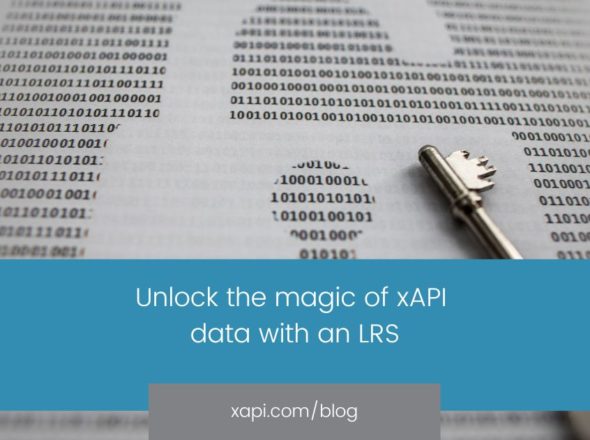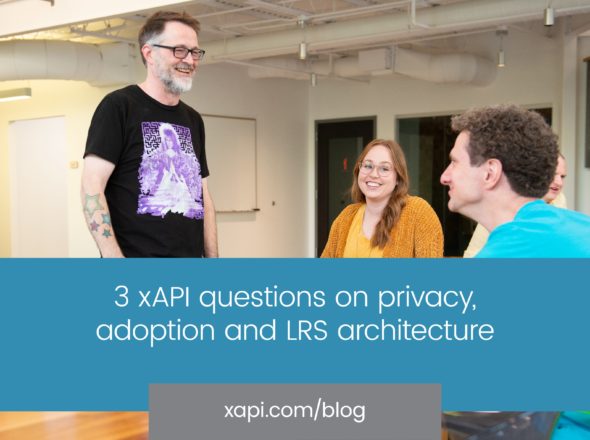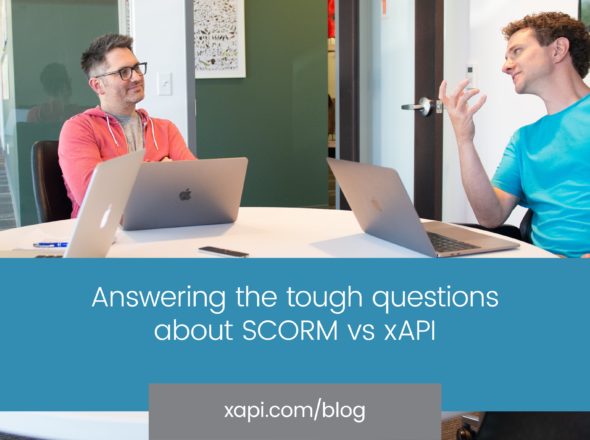The following article is written by guest blogger Marjaana Jokinen, an incurably development-oriented learning engineer and information developer. Learn more on her blog. To submit a guest blog you’ve written, fill out our form.
How do you start learning about a new thing when there is nobody to teach you hands-on or share examples? What are the questions on your mind that you want answered? Here’s a story of tackling the eLearning standard the Experience API (xAPI). It’s a snapshot of how a set of basic questions turned into bigger questions through “minimum viable” experiments.
“It’s the new SCORM, right?”
xAPI has been on my radar for several years. The first encounter was already in 2013 or 2014 when it was still called “Project Tin Can”. I was working with Learning Management System (LMS) projects and occasionally also came across problems with SCORM.
Back then, I sort of got the idea of Tin Can (now commonly referred to as xAPI) somehow being a new, improved SCORM. I sort of understood that another system, a Learning Record Store (LRS), is needed to display whatever data the interface generates. I sort of understood the idea of having an actor-verb-object type of syntax to describe detailed learning events (like, John watched video1). But I didn’t fully understand why anyone would analyze learning in such detail.
One day last summer my Twitter feed promoted a free online course titled “Understanding impact: the xAPI’s final frontier.” Always hunting for new and interesting L&D-related courses to study, this MOOC sounded really useful. In this course, my understanding exploded.
“Oh. OK. So it’s much more than SCORM?”
The first thing I learned was that xAPI enables system interoperability. It has more to do with different systems sharing data than with just fixing what’s not working with SCORM. It’s about going beyond the LMS-oriented ways of thinking when capturing learning. It’s about connecting learning to the real world and actual performance in measurable ways.
So I started reading more. I learned about why we still need LMSs and SCORM packages. When xAPI is not the right solution. Why L&D is not the only organizational unit that should be involved in discussions about xAPI adoption. Why, after five years since xAPI’s introduction and all of its promise, it’s still thought of as “the new kid in town” and you don’t hear about success stories very often.
It seemed to me that people are scared of all the geeky stuff that is involved with xAPI. Now, I’m not afraid to go geeky, but even I was wondering:
“Do I have to start coding now?”
Hungry for more, I stumbled across Torrance Learning’s xAPI Cohort Fall 2018 edition. This was another useful resource I found via my Twitter feed. Not only was the Cohort meant to be virtual, open and free but it would also include “geek-free” things about xAPI. Yup, never mind the timezones, I signed up!
This Cohort was a chance to hear weekly presentations with xAPI examples by experts, attend discussions, hear about how other people use xAPI and get ideas for useful tools. Although I didn’t contribute to the teams, my main take-away from the Cohort was finding the courage to start experimenting on my own, without the need of learning JavaScript Object Notation (JSON) in depth or even having access to eLearning authoring tools.
I was able to harness my own WordPress site as an xAPI sandbox. I created a quick-and-dirty H5P interactive video to capture user activities and installed a couple of plugins to connect to a free LRS by ADL. By setting up dummy user accounts at the back-end, I was able to authenticate different users in the sample data. I didn’t set out to do big things. My only goal was to see:
“What happens if I just try this?”
The first milestone was seeing the JSON statements coming through in the LRS. Although it’s hard to find things that are more boring, I was thrilled to see lines of text with “Xavier interacted with video1” and “Xanna completed the quiz” populating a page in the LRS when clicking my H5P demo.
The second milestone was connecting to a trial version of a commercial LRS, Yet Analytics, and seeing visual graphs from my demo users’ experiences. Individually, the statements did not add much value but in larger quantities you could see trends emerge and work with the data in various ways.
And since things were ticking nicely, I didn’t stop there. The third milestone was to break free from WordPress by connecting a bookmarklet tool to the LRS. I was now able to send statements from reading a web page or tweeting about reading a web page and visualizing these things in various ways. I was now literally accumulating learning data from, well, anywhere.
I could get to this point without coding anything myself. Of course, it helps to know JavaScript in case you want to create tailored solutions. For this level of knowledge, I warmly recommend the “xAPI Fundamentals” online course at Udemy. (Another tactic is to find a software developer to talk to, which I have also done.)
“And what am I going to do with all this data?”
At the moment, my learning curve has taken me back to the original questions from 2013 or 2014: why would anyone collect all this data about learning?
Recent years and more experience from L&D tasks have taught me that people learn in various places in addition to the LMSs: mobile games, simulations, conferences, coaching sessions, TED talks, YouTube videos, you name it. In the future, it will be even more so. xAPI makes these blended learning experiences visible and measurable. It helps organizations see where their training efforts are having the most impact or where things should be improved.
The more I learn, the more I see the need to step back and think strategically: what type of data to collect, which learning experiences to track and which systems to pull data from? Connecting learning data with on-the-job performance or customer data from the CRM is a typical scenario but what else could there be? Also, how can xAPI data help us improve or personalize learning content?
At this stage of my personal journey, I want to understand more about these different use cases. I also want to pay forward what I’ve learned from various online courses, social media discussions and professional communities that share their knowledge openly and have invited newbies like myself on board.


